Thank you to all the volunteers who have participated in The RBGE Herbarium: Exploring Gesneriaceae, the African violet family. The project data is now available for reuse. For details, see the Results page. All data is presented in an anonymised form. If you used a Zooniverse account to participate in this project and would like to request for your anonymised data to be deleted, please contact research@nationalarchives.gov.uk
FAQ
FAQs
We will continue to add more faqs as the project progresses based on the questions that arise:
What is a herbarium specimen?
During botanical expeditions plant material is collected, pressed and dried. This is sent to herbaria where it is mounted on archival paper. Most of the characteristics of living plants are visible on the dried plant. The few that are not (e.g. flower colour, scent, height of a tree, vegetation type) are written on the collection label by the collector. Most importantly, the label should tell us where and when the specimen was collected.
What is a herbarium?
A herbarium is a collection of herbarium specimens, catalogued and arranged systematically for study by both professional taxonomists (scientists who name and identify plants), botanists and amateurs.
A working reference collection
A herbarium acts like a plant library or vast catalogue with each of our three million specimens providing unique information – where it was found, when it flowered, what it looks like and it’s DNA, which remains intact for many years. DNA is now routinely extracted from herbarium specimens.
This unique working reference collection brings species from all over the world together into one place to be described and compared. The work is disseminated through the writing of Floras (a description of all the plants in a country or region), monographs (a description of plants or fungi within a group, such as a family) and scientific papers. This fundamental research provides an essential baseline for other plant-based research and helps inform conservation practices.
What is an indexed project?
The RBGE Herbarium: Exploring Gesneriaceae, the African violet family is one of three projects trying out a new indexing tool in Zooniverse. The others are HMS NHS: The Nautical Health Service and Scarlets and Blues.
Zooniverse projects would usually present subjects (for this project herbarium specimens) to transcribe in a random order. These projects let you search and choose which subjects you want to transcribe.
See the following Zooniverse blog post on this new feature.
How do I choose a record?
-
Decide what workflow you would like to work on by either clicking on Geography or Latitude/Longitude.
-
Pick a subject set.
Each set is grouped together by the region of the world they came from. Herbaria organise their collections into floristically meaningful geographical regions from which they were collected. RBGE has split the globe into 19 regions (within which some of these have further subdivisions).
RBGE Herbarium world regions
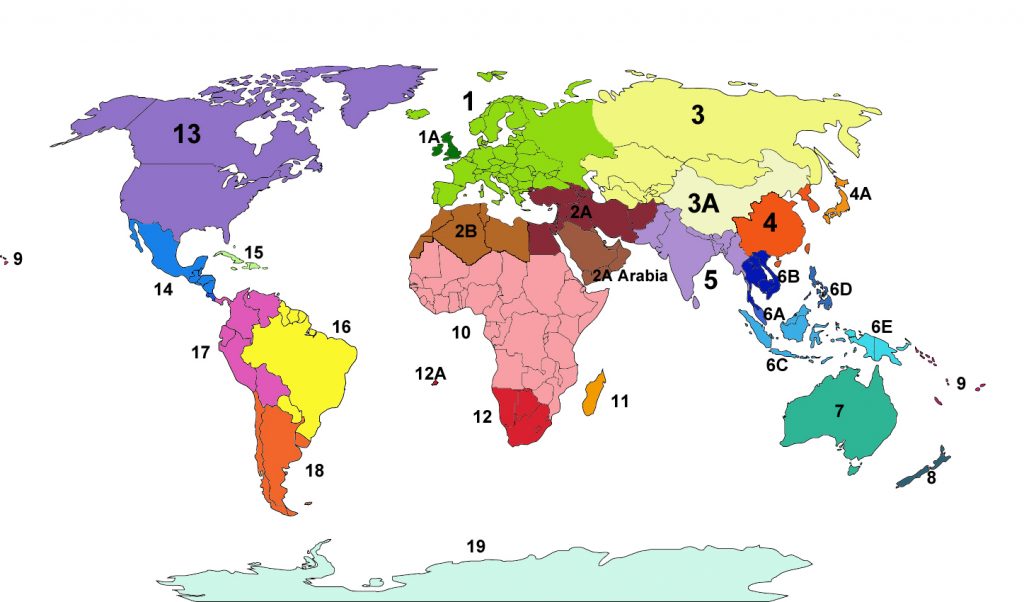
Subject sets grouped by geographical region
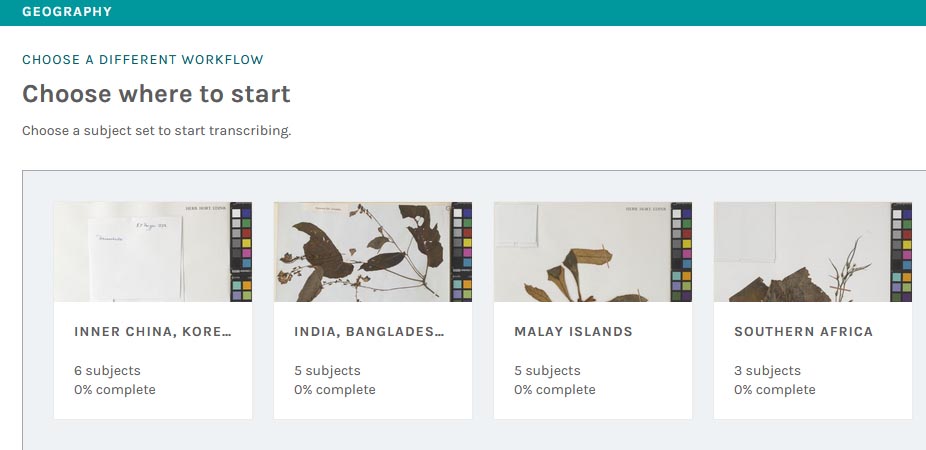
- Pick a specimen from within the subject set to transcribe from the subject set index:
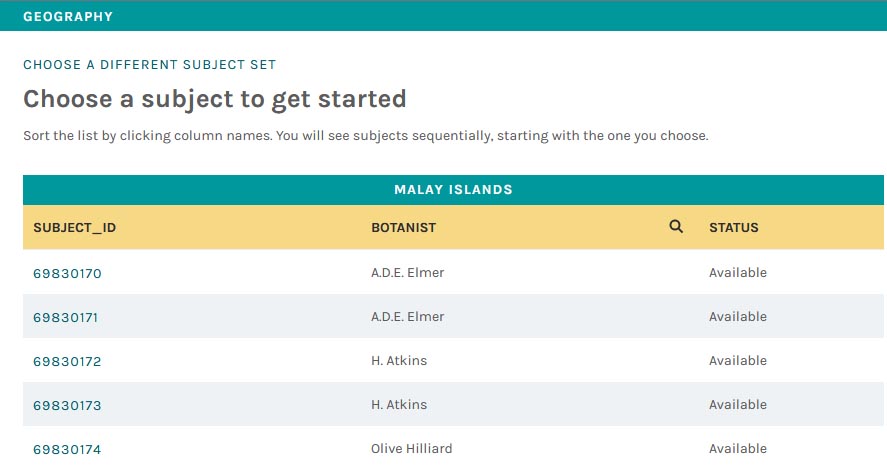
SUBJECT_ID links to the page. Click on this to start transcribing.
BARCODE This the unique identifier that we use to link each herbarium specimen database record to its image. It is also used to cite a specimen in scientific papers.
BOTANIST We have used optical character recognition to identify the botanist who collected each herbarium specimen.* This means you can choose to work on specimens collected by a specific collector from specific area of the world.
SPECIES
This is the scientific name of the species we currently recognise the specimen to be and is used in the physical filing of the specimen within the herbarium. It consists of a Genus (the first letter is always capitalised) specific epithet (all lower case) and author string (the person who described and published the scientific name. This is often abbreviated to a standard form).
E.g. Bellis perennis L.
'Bellis' is the genus, 'perennis' is the specific epithet and 'L.' with the author string and is the standard abbreviation for Linneaus.
STATUS tells you the status of the specimen. Available means that the specimen still needs transcribing. Already Seen means that you have already transcribed this record, but it is waiting to collect more transcriptions from others (each specimen is transcribed three times for verification purposes). Retired means that it has been transcribed three times, but you can still look at if you want to refer to it for any reason.
You can search and sort on the Botanist or species in the index
To search a column click on the magnifying glass icon to the right of the column you want to search and type the search term you want to use
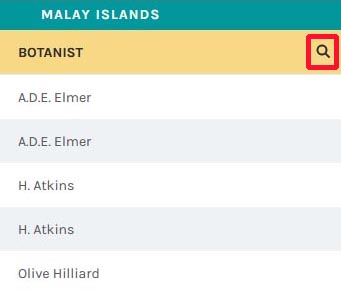
To sort click on the column to sort in ascending order (A-Z/1-10) click again to sort by descending order (Z-A/10-1)
In the example that follows, the surname ‘Elmer’ has searched for in the Botanist column and species sorted in ascending order:

In this next example the genus 'Cyrtandra' has been searched for in the species column and botanists have been sorted in ascending order:
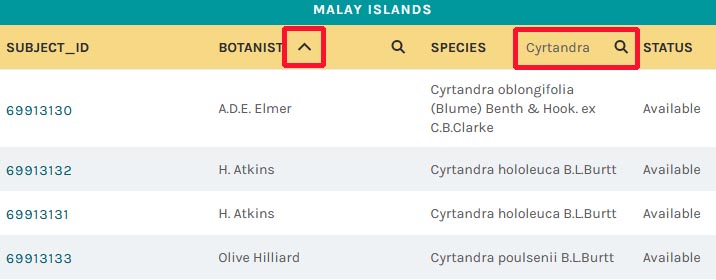
* As the OCR server reads the whole image of each specimen and produces an unparsed (one long string of text) output of all text on the specimen. You may come across specimens where a botanist is mentioned elsewhere on the specimen but is not the collector. The OCR is quite accurate with printed text and old collections often have printed headers like the example from a specimen collected by George Forrest below. OCR is not able to accurately decipher collection label handwriting which is why transcription projects like this are vital.
What is the previous and next feature?\

At the top of a particular subject you will see a banner which says has 'previous' and next 'navigation' buttons. This ‘pagination’ feature is currently unique to this project. It allows you to move forwards and backwards through a subject set to decide what to work on.
How does pagination relate to specimens?
Often specimens are only mounted on one sheet. Sometimes specimens are so big they are mounted on multiple sheets - at this stage of digitisation we do not have this information.
We have used the pagination tool to group specimens from a particular botanist. Previous research at RBGE indicates working on a particular Botanist's collections allows transcribers to learn a particular botanist's handwriting and phrases, increasing the ease and speed of transcription. We are very interested to see if you find the same!
Do I need to transcribe diacritcal marks/accents?
You do not need to transcribe diacritcal marks/accents e.g. Pyrénées can be transcribed as 'Pyrenees'